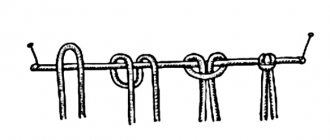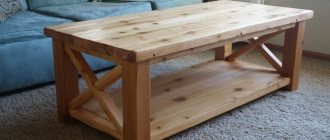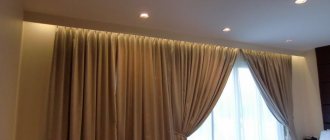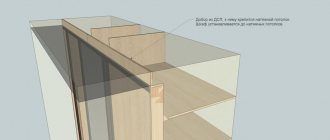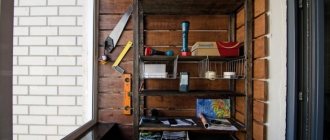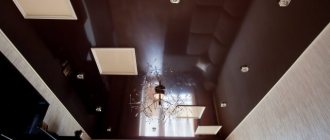For every person, the completion of a renovation is comparable to a holiday, which symbolizes the establishment of familiar order in the house. Smooth walls, ceilings and expensive flooring, what could be better? Any person strives to equip his own home as comfortably as possible, sparing no effort and money to make his dream come true. There are situations when nothing depends on the owner, and the premises fall into disrepair. There are many reasons, however, the most common is a malfunction of the water supply system of the neighbors above. In this case, the ceiling takes the greatest impact.
- How to remove a suspended ceiling with a harpoon type of fastening
- Important aspects of dismantling the tension fabric
Old pipes and accumulated moisture can cause mold and leaks on the walls, and damage to electrical wiring. The cost of suspended ceilings is high, regardless of the complex installation work. However, the material belongs to the reusable category and with proper dismantling, subsequent installation of the canvas in its original place becomes possible. A short break in the matter will be beneficial and will give the owners the opportunity to put all the problems in order.
First stage
To figure out how to remove the stretch ceiling, you need to find out how it was secured. Information about the fastening method is usually indicated in the warranty card for the PVC structure along with data on the warranty period. We will be based precisely on this information. If nothing is indicated in the documents, you can find out everything yourself.
There are 4 methods for fixing the tension fabric on the frame:
- Harpoon method
. The most popular and simplest method of fastening the canvas. With this approach, a hard harpoon-shaped edge is welded around the perimeter of the canvas, which is inserted behind the frame, unbends there and maintains tension. - Cam or clip method
. In this case, special plastic clips are used to secure the canvas. In this case, you can do without preheating the canvas. In addition, no additional decorative elements or plugs are required. - Beading
fixation involves pressing the PVC film to the canvas from the inside using beads.
When attaching suspended ceilings using the last two methods, it is worth understanding that the film is in contact with the profile, so it is important to be especially careful not to damage it.
Specifics of working with PVC material
As a rule, suspended ceilings are made from PVC film - this option is cheaper than fabric, easier to care for and easier to install. Polyvinyl chloride film is very elastic, durable, and environmentally friendly. In addition, when heated to 60℃, PVC becomes even more elastic and can be stretched. As the material cools, it becomes denser and contracts. This property of PVC is used to create a decorative and beautiful stretch ceiling. A special heat gun is used for the work.
Although PVC film is very difficult to tear, it is sensitive to cuts from sharp objects. In case of such damage, the coating will have to be completely replaced.
Cost of re-upholstering the ceiling
Regardless of who carries out the work, the matter will require costs. The cost of manually performed operations is not always cheaper than calling in specialists. In the absence of experience, the home master will make errors in calculations and mistakes, which will lead to the complete collapse of the structure and the rapid appearance of defects. Here it’s easier to contact the company: the craftsmen will provide guarantees for the service of reupholstering the ceiling with fabric, the price of which will be from $7-9 per m2. They will complete all processes quickly, using the right tools and with extensive experience. The main thing is to turn to reliable professionals and clearly define: the type of fabric, fastening features, the possibility of re-upholstering, the need to install lamps and other nuances of the work.
The procedure for disassembling a stretch ceiling
To understand how to carefully remove a suspended ceiling, you should read the detailed instructions, purchase high-quality tools, and also treat the process with all possible responsibility.
Preparation stage
Before you remove the suspended ceiling yourself, you need to prepare the special tools that you will need during the work process.
For this task you will need:
- Special clamps for fixing the tension film.
- Heat gun - it is recommended to use gas units, their power is quite sufficient for working in an apartment. If you use electrical devices, you can damage the wiring, since it is not designed for equipment of such power.
- A narrow spatula for working with suspended ceilings (10 cm). It must first have rounded edges and ground off the edges to eliminate the possibility of damage to the PVC sheet.
- Standing structure - stepladder, table or sawhorses.
- A screwdriver with a curved end.
- Pliers with curved ends.
- Stationery or construction knife.
If all the specified devices are at your disposal, the preparatory stage can be considered complete.
What you should know about the types of tensile structures
In principle, there are now only two types of such ceilings:
- Fabric (seamless) structures. When installing these systems, there is no need to use bulky “heat guns”; this is an undeniable plus. The installation of such canvases should first be done in the centers of the rooms, and then you can gradually begin to move to the corners.
- PVC buildings. Both fixing and removing ceilings of this type require mandatory heating of the premises. Otherwise, you can simply ruin the delicate tension films. Therefore, specialists always use the same “heat guns”, moving from the corners of the rooms to their centers.
Preliminary work with the premises
Before opening the suspended ceiling, it is necessary to perform certain preparatory work:
- Remove lighting fixtures from the ceiling that interfere with further work on the ceiling.
- Remove all indoor plants from the room, and also take out cages with pets or birds, if you have them.
- Cover furniture and interior elements that have not been removed from the room to protect them from the high temperature generated by the heat gun. This applies, among other things, to window and balcony frames, plastic inserts on the walls and other decorative elements.
Upon completion of all this work, the suspended ceilings can be dismantled.
Dismantling the tension fabric
The answer to the question whether a suspended ceiling can be removed depends on what type of fastening was used during installation, as well as the quality of the fabric used. Based on the type of fastening, the process of dismantling the film will be slightly different.
It is worth noting that the approach to removing the entire ceiling or just a separate section of it will vary. Let's consider each option separately.
Harpoon mount
In this case, the process of removing a suspended ceiling will be the easiest to complete. The fact is that the assembly principle itself involves repeated assembly and disassembly of the ceiling. Work on dismantling the canvas fixed in this way should begin from the corner.
Let's look at a detailed algorithm for how to remove suspended ceilings installed using the harpoon method:
- We dismantle the decorative edging tape on one side or along the entire contour of the canvas in order to provide access to the areas where the PVC film is attached.
- We determine the location of the slotted inserts that were fixed between the walls and the canvas. Let's dismantle these elements.
- We heat the air in the room to 70 ℃ using a heat gun. This is a prerequisite for successful film dismantling. The heated fabric will become significantly softer and begin to stretch, which will facilitate the work of removing it from the fastenings.
- At the next stage comes the most crucial moment in the process, how to properly remove a suspended ceiling. First you need to warm up the section of the canvas from which the work of removing the film will begin. On a flat surface, you usually start from the corner, but on curved surfaces, it doesn’t matter where you start from. Having secured yourself on the stepladder, take a dull spatula and use it to hook the harpoon. Then, using pliers, we remove this harpoon from the profile.
- After this, we bend the PVC sheet towards ourselves.
- Next, very carefully and slowly remove the film from the mounting profile, trying not to damage it. If necessary, we additionally warm up individual areas with a heat gun.
In the case of fabric canvases, the process of carefully removing suspended ceilings will look completely different. We'll talk about it in more detail a little further.
Removing the fabric ceiling
In the case of a clip fastening, it is easy to remove the textile ceiling. There is no need to warm it up. If trim is installed, remove it. Then press on the part of the clip in the profile that is located against the wall. The clip will open and the blade will be released. Pull the free area. You won’t have to disassemble anything else if removal was required to eliminate defects, electrical wiring breakdowns, or the consequences of flooding. Reinstalling the canvas is also easy. The technology requires the craftsman to wrap the edges of the fabric into a clip. A special round spatula is used.
Cam fixation
The technology for removing a suspended ceiling mounted using the cam method is the simplest and least burdensome. You don't need a heat gun to implement it. However, since during the work the spatula comes into direct contact with the tension fabric, you should be very careful and attentive.
In this case, there are two main methods for removing a suspended ceiling:
- We will need two screwdrivers. We place one of them between the fists in the corner of the room, and insert the second with a distance of 55-60 cm from the first. Thus, the pressure on a specific section of the ceiling will be significantly reduced, and a small section of the canvas can be removed from the fastening. You need to repeat these steps until the required section of the stretch ceiling is released.
- To work you need a spatula. It must be inserted between the cams and the movable element can be bent. This will create the necessary tension so that the PVC film comes out of the clamps. All other material can be pulled out of the grooves manually.
The clips always leave special notches on the stretch PVC film, which will allow you to mount the ceiling in the future exactly as it was installed before.
Reasons for dismantling
Let's figure out when radical methods (complete dismantling) are required, and in which cases you can do without it.
- Small damage to the surface . PVC film is a material that can be easily damaged by using sharp objects, throwing things up, and so on. If the section of the coating that is located close to the edge is torn, then after partial dismantling, the torn fragment should be carefully removed. Next, the damaged area is carefully glued to the edge near the harpoon, and then inserted into the baguette. With a wedge fastening method, rather than a harpoon, it is much more difficult to disguise the damage. If the coating comes off along the baseboard, it cannot be restored. Large cuts in the canvas can be sewn up with nylon thread, but the ceiling will not look aesthetically pleasing.
- Sagging and major damage. Sagging is the result of sudden temperature changes. It can also occur due to improper installation. If the canvas is sagging and the warranty period has not yet expired, you should contact the company that did the installation. Company employees are required to correct this deficiency at their own expense. Large tears, especially where pipes are located, are very difficult to seal. Often, in such situations, the canvas is completely replaced.
- Accumulation of moisture. Flooding by neighbors from upper floors is a common situation in apartment buildings. The result is sagging of the canvas in those areas where liquid has accumulated. The water can be drained by removing the chandelier (if there is one) and get rid of the liquid through the small hole formed. Before you begin, you must turn off the electricity supply to the room. Also, you need to prepare dishes for draining. When there is no liquid left at all, the flooded area needs to be thoroughly dried. The best option is to completely remove the canvas and dry it. If for some reason this is not possible, you should turn on the fan heater and leave it until the remaining moisture has completely evaporated.
- Fungus . If the fungus has “attacked” the suspended ceiling, dismantling will be required. Also, it is necessary to treat with an antiseptic so that mold does not appear on the new coating.
Bead fastening
In this case, in the process of removing the suspended ceiling and putting it back, you will need the following:
- the spatula mentioned above;
- screwdriver;
- heat gun.
The sequence of actions will be as follows:
- First you need to warm up the room (using the same principle as before).
- Remove the plug.
- Using a spatula, starting from any corner, squeeze out the outer wall of the baguette. Next, use a screwdriver to hook the glazing bead and remove it.
- We pull the glazing bead with our hands and remove the canvas.
If there was excess material left during the installation of the ceiling, then if necessary, the canvas can be inserted back.
How to properly remove seamless fabrics
To remove the old suspended ceiling as best as possible, if it is made of fabric, you do not need to warm up the room very much. If glazing bead or wedge fasteners were used, then the process of removing the canvas will be the same as in the case of PVC film, with the only difference being that the work should begin from the center of the wall with gradual movement to the corners. The situation is the same with installation. The quality of the work performed will largely depend on the accuracy and slowness of the operations performed.
If, in the question of how to remove a suspended ceiling and put it back, you still have to reinstall it, then the final success largely depends on how well the previous installers worked. If the material was cut end to end, then most likely this will not give us the opportunity to obtain sufficient tension after re-installation. This is because polyester does not have the same elasticity as PVC material. However, if the installation was carried out by professionals, then we can hope that they provided a few extra centimeters of canvas. In this case, no significant nuances should appear.
It is worth noting that before bending a stretch ceiling made of fabric and putting it back, if it was installed using clip-on baguettes, you need to take into account several nuances. Such ceilings cannot be partially disassembled - you will definitely have to remove everything at once, otherwise the canvas can easily come off the clamps due to the insufficient reliability of this type of fastening.
In the process of removing and installing a suspended ceiling, it will need constant heating, although in this case the heating may not be as strong as when using PVC material. If after installation there are minimal unevenness left, then do not worry - just warm up such places with a heat gun and they will easily level out. At the same time, do not lift it very close to the surface of the canvas, because, being plastic, such material can easily deform.
Fastening systems and types of canvases
Today in construction stores you can purchase a wide variety of tension structures. Depending on the type of fastening, the list of its parts also varies. Usually they offer one of three types of fastening systems shown in the tables below.
| Type of fastening system | Harpoon mounting system | Clip fastening system | Bead fastening system |
| Type of baguette | H-shaped baguette | P-shaped baguette | U-shaped profile |
| Parts used | Harpoon, baguette, decorative overlay | Baguette | Profile, glazing bead, plug |
| Application | PVC sheets | Fabric sheets | PVC and fabric sheets |
| Is it possible to dismantle? | Available | Available | Complicated |
The fastening system helps to understand how to remove the stretch ceiling structure, and the possibility of its removal determines the type of ceiling - PVC or fabric. This can be determined visually (if you know what the appearance of the fabric looks like visually), or by asking the company that installed the tension fabric.
To remove the PVC sheet without damaging it, you need a heat gun, just like during installation. Without heating the canvas, it may be damaged and there will be no way to return it to its place. Both installation and dismantling of PVC stretch ceilings is carried out from the corners to the middle of the wall, slowly warming up the canvas.
The temperature inside the room where the stretch ceiling is being dismantled is high and before work it is better to foresee this by moving all the furniture outside the room. It is difficult to dismantle a PVC sheet on your own, and it is better to leave this work to a construction team that specializes in this type of work.
It is quite easy to remove a fabric stretch ceiling without damaging it, since this type of fabric does not require heating and can be dismantled without the involvement of a construction team.
Useful tips from professionals
In order to remove the canvas around the entire perimeter, as well as the corner of the stretch ceiling, as quickly and efficiently as possible, we advise you to follow the following, quite important tips:
- To ensure installation work is carried out accurately and safely, it is better if you are assisted by one or two assistants.
- To install a ceiling made of tension material, choose only high-quality materials.
- Try not to use tools with sharp edges.
From the above we can conclude that dismantling a stretch ceiling is not difficult. Such work can easily be done with your own hands if you follow the basic recommendations and follow the technology.
Reasons for sagging ceilings
The regulations for installing a suspended ceiling say: the permissible sag of a fabric ceiling cannot exceed 1% of the diagonal size of the ceiling area. If the canvas hangs more, it will have to be tightened, but here are the possible causes of sagging:
- High room temperature. The taut fabric is loosened by heat. For example, in the kitchen above the stove. After the temperature normalizes, the defect disappears.
- The weight of the fabric also changes the tension. With any installation technology there is a certain percentage of sagging, this is approximately 0.5 cm for every 20 m2 of fabric area. The larger the space covered, the faster the fabric deforms, so experienced professionals advise stretching the fabric with separate separating-type profiles to reduce the risk of deformation.
- Leak. A fabric stretch ceiling changes shape if the neighbors above do not turn off the tap. The defect can be eliminated only by releasing water and subsequent re-tightening.
- Defective canvases that do not meet quality standards will sag very quickly.
- The baguette moved away from the wall. This problem appears with intensive frequent fastening of profiles mounted on fragile plasterboard walls without mortgages.
- Poorly insulated ceiling. Before installing the fabric, the base must be cleaned, holes and cracks sealed. Otherwise, the plaster and pieces of the base will fall off from the ceiling - all this will lead to deformation and weakening of the tension.
The annual sagging of the structure should not be overlooked. Only harpoon fastenings are not subject to this problem, but clip and bead fastenings become deformed after 5-7 years. But until the fabric begins to sag more than 0.5-0.7 cm per 20 m2, there is no reason to worry, and when the defect is visible to the naked eye, the design changes completely. Fabric ceilings wear out over time, the material thins out and after many years of use, re-upholstery is impossible.

